 I'll confess: I’m fully aware that's a ludicrous title, but it's absolutely what I'd use if I were to write a slightly overwrought academic monograph on the subject. We've arrived here because I kept intending to write something about beer and 'authenticity,' but that was too pretentious even for an overloaded title like the one above. I toyed with writing about the phenomenology of the beer landscape, but know that would appeal to the three, perhaps four other beer nerd ex-archaeologists who had to read Chris Tilley's A Phenomenology of Landscape back in the 1990s, I decided that, too, was impractical. But I still wanted to land in a similar space: how has beer evolved over the past two decades, and how has the way we experience it changed?
I'll confess: I’m fully aware that's a ludicrous title, but it's absolutely what I'd use if I were to write a slightly overwrought academic monograph on the subject. We've arrived here because I kept intending to write something about beer and 'authenticity,' but that was too pretentious even for an overloaded title like the one above. I toyed with writing about the phenomenology of the beer landscape, but know that would appeal to the three, perhaps four other beer nerd ex-archaeologists who had to read Chris Tilley's A Phenomenology of Landscape back in the 1990s, I decided that, too, was impractical. But I still wanted to land in a similar space: how has beer evolved over the past two decades, and how has the way we experience it changed?
Back in the day - say, 20-25 years ago, at least for the US - the prevailing themes of craft beer* were around rejecting bland, macro-brew lager (recall, microbrew was the preferred term before 'craft' took over) and championing independent small businesses. Commercially-available craft beers had evolved from what was relatively easy to homebrew, so more ales than lagers in general, and there was often an emphasis on British styles; every brewpub seemed to have a brown ale as their flagship, and a pale ale as their entry point. Edgier ones would throw in something vaguely 'Belgian' (really, usually just something a bit yeastier), and those that were more confident in their abilities had German styles that were clearly distinguishable to the first-timer from the dreaded watery lagers sold at your local ballpark. Occasionally someone would really push the boat out, for example, Nodding Head's add-your-own woodruff Berliner Weisse** - a beer I sorely miss – but even double IPAs were relatively rare. It's easy to look back and decide that 'we' - the self-identified group that's decided that caring about quality beer is worth our time and, to some extent, allegiance - have succeeded. As consumers, we can get flavorful, reasonably 'interesting' beers everywhere from the ballpark to the high-end restaurant (though, perhaps, getting the dive bars to serve the local craft brew was the last holdout). But while in many cases the maturity of the beer market has meant you can get a good IPA at the airport, it's also led to the odd experience of *only* being able to get an IPA at the airport; the promise of endless variety has, rather ironically, led to more and more similarity.
Regional differences abound, however; in the Philadelphia area (where you can't buy beer at most supermarkets, convenience stores or similar retail outlets, because THINK OF THE CHILDREN), there is still certainly a focus on local and regional breweries. Despite that, it's much easier to find beers from further afield, whether that means from across the country or the other side of the world. The local emphasis makes plenty of sense economically and from a freshness perspective, but I had no trouble there finding excellent beers from my current coast - there's always Pliny the Elder if you want it, or many San Diego-brewed beers - or British favo(u)rites from Adnams or Coniston, not to mention good representation from Belgium, Germany, Australia, New Zealand, Japan and even Brazil. Popular styles fluctuate, but you can always count on being able to find a good lager from Victory (or Germany), an excellent bitter from Conshohocken Brewing Company, a great mild from Yards, or something experimental-but-fabulous from Tired Hands. Yes, everyone also brews an IPA of some sort, but they aren't necessarily company flagships. Local confidence in a great product seems to invite imports and collaboration, rather than a trend toward homogeneity and endless hazy IPAs.
 YES, WE'RE ALL INDIVIDUALS
YES, WE'RE ALL INDIVIDUALS
By contrast, many - though not all - breweries here in the Seattle area seem to be playing follow-the-leader; there's variety in the IPA (and now, New England/hazy IPA) labels, but the beers are very much the same, and frankly not (again, with a few exceptions) amazing. Finding anything that's not a Fill-in-the-Blank 'IPA' or 'sour' can be tricky. I could write a very long, tedious piece on how 'sour' as a catch-all term is Not Particularly Accurate Nor Useful, but you already know that, so we'll take it as understood, but I'll also happily accept not buying someone's poor-sanitization accident in exchange for having Reuben's Gose or Dogfish Head's Seaquench readily available. But even at my favorite local bottle shop, which has friendly, knowledgeable staff and an interesting selection, there are far more refrigerated cases dedicated to 'sours' and 'IPAs' - 8 of sours alone, to 5 IPA, if you're keeping track at home - and about a quarter of a single case with 'malty' - the few local milds, porters and stouts still available, and many, if not most, of those stouts are 'imperial.' No doubt this scene is replicated in bottle shops across the US to a certain extent, and this may be part of the shift in tastes that is leaving former ‘white whales’ on the shelf.
While 10 years ago it would not have been remarkable to see people lining up to buy Goose Island's Bourbon County Breakfast Stout, it's now something that sits on supermarket shelves. Some of this is, one presumes, in response to In-Bev's purchase of Goose Island; one wouldn't want to be seen drinking a Secret Macrobeer, because Craft Beer Is Part Of Your Identity. And shifting tastes are no doubt at play to some extent as well, but I suspect two other factors are also in play: novelty and availability. When it was hard to find, either because of true logistical constraints or by design, it was Important and Special. Nownot so much.
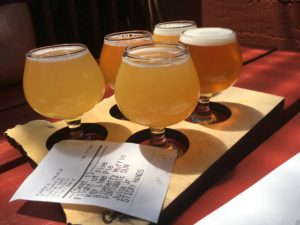 I'm certainly just as guilty as any other beer nerd of wanting to try All The Things; if it's new to me, it's got to be worth a try, right? While this is a lot of fun at beer festivals, and fabulous when traveling, it also means that the number of Really Terrible Beers consumed gets to be a lot higher than the number of Really Good Beers. I'm absolutely convinced the uptick in 'sours' is largely because many newer breweries have not mastered the basics (though, interestingly, they managed to get themselves funded by some means – there’s another avenue to explore), and slapping a 'sour' label on a large percentage of your offerings is a great way to attempt to cover this up. And, frankly, in an industry where a lot of people aren't making a lot of money, but there's a high cost for ingredients and distribution, it's hard to blame them. I'll reiterate that there are breweries that are doing absolutely fantastic things in this space - but more and more of what's generally available in these categories is not even good, and then they don't produce anything basic (or, perhaps to some, ‘Basic’) like a pale ale or pilsner (I know not to even both looking for a bitter from most producers around these parts). For too many of my local breweries, their current lineups seem to all have 2 hazy IPAs, something 'sour' with fruit, something 'sour' without and maybe, just maybe, a straightforward (albeit 7%-ish) IPA. If there's a stout or porter, it's most likely barrel-aged and around 12%.
I'm certainly just as guilty as any other beer nerd of wanting to try All The Things; if it's new to me, it's got to be worth a try, right? While this is a lot of fun at beer festivals, and fabulous when traveling, it also means that the number of Really Terrible Beers consumed gets to be a lot higher than the number of Really Good Beers. I'm absolutely convinced the uptick in 'sours' is largely because many newer breweries have not mastered the basics (though, interestingly, they managed to get themselves funded by some means – there’s another avenue to explore), and slapping a 'sour' label on a large percentage of your offerings is a great way to attempt to cover this up. And, frankly, in an industry where a lot of people aren't making a lot of money, but there's a high cost for ingredients and distribution, it's hard to blame them. I'll reiterate that there are breweries that are doing absolutely fantastic things in this space - but more and more of what's generally available in these categories is not even good, and then they don't produce anything basic (or, perhaps to some, ‘Basic’) like a pale ale or pilsner (I know not to even both looking for a bitter from most producers around these parts). For too many of my local breweries, their current lineups seem to all have 2 hazy IPAs, something 'sour' with fruit, something 'sour' without and maybe, just maybe, a straightforward (albeit 7%-ish) IPA. If there's a stout or porter, it's most likely barrel-aged and around 12%.
Once again, I'm all for people who do those things well doing them - but it would be great to see them as a seasonal or otherwise special creation, rather than the only thing available. I recently went out to a new beer-focused restaurant in the area that had 22 taps - not one beer was under 7%, and the vast majority were either hazy IPAs or what I can only describe as fruity nonsense, with no real tie to any particular beer style. I had real trouble finding anything I wanted to try, let alone have more than one of. It seems we've officially jumped the shark on beer styles and variety - there's certainly the illusion of diversity, but when you take a closer look, it's the same thing, again and again. To be clear, I don't believe all hazy IPAs are bad, by any means; I've had some that were very good. My issue is that I can't seem to find ANYTHING ELSE of lateit was so refreshing to be back in London over the holidays, where the variety of beer on offer was a lot closer to what the US had in the early 2000s, and there were, of course, many more beers under 5% (even under 4%!).
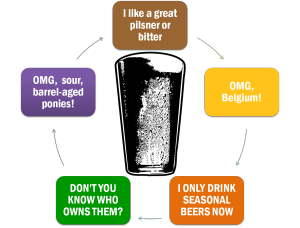 I'm not entirely certain whether this is just Where We Are in the beer cycle, or if this is a regional quirk; when we go to Portland, there is certainly plenty of variety and the quality bar is very high, thanks to a very sophisticated local consumer base (and, one presumes, a lot of cross-pollination from brewers moving from one local company to another), and our trips elsewhere on this coast have turned up more pale, cloudy IPAs than I would prefer, though also a wide selection of local stalwarts making things that are recognizably beer to the casual observer. Even tiny Bellingham, up near the Canadian border, punches well above its weight in terms of beer quality and variety. Nevertheless, it still seems that at least locally, in the rush to brew unique beers that appeal to the more hardcore - and much more fickle - beer nerd audience, everyone has managed do exactly the same thing.
I'm not entirely certain whether this is just Where We Are in the beer cycle, or if this is a regional quirk; when we go to Portland, there is certainly plenty of variety and the quality bar is very high, thanks to a very sophisticated local consumer base (and, one presumes, a lot of cross-pollination from brewers moving from one local company to another), and our trips elsewhere on this coast have turned up more pale, cloudy IPAs than I would prefer, though also a wide selection of local stalwarts making things that are recognizably beer to the casual observer. Even tiny Bellingham, up near the Canadian border, punches well above its weight in terms of beer quality and variety. Nevertheless, it still seems that at least locally, in the rush to brew unique beers that appeal to the more hardcore - and much more fickle - beer nerd audience, everyone has managed do exactly the same thing.
But it's not all doom and gloom in Seattle, by any means; it's just a bit harder to get the good stuff than it should be. Machine House makes absolutely outstanding English-style ales, and I'm excited they are opening a second location, but alas, the fact that it won't be family-friendly means I'll have perhaps an annual chance to visit. Their existing brewery does welcome the whole family, but there's not a useful way for us to get there via public transit, so it's also something that means a special trip, not a regular weekend visit (although it's only 10 miles away in the south part of Seattle, it would nearly be faster to drive to Bellingham and walk from brewery to brewery there while enjoying a hotel getaway – but at least that will be less of an issue when our smaller child is old enough to Lyft and/or the older one responsible to babysit – someday). Fortunately, Machine House's cask ales do make an appearance at two bars that are walking distance from my office from time to time - though again, that's something that needs additional planning - but they are often the guest cask at nearby Elliott Bay Brewing, which does welcome the kids, so it's somewhere we may actually visit for a weekend meal. I'm still crossing my fingers that The Shambles, the excellent newish fancy bar across the street from me, will eventually get a hand pump or two; even though they are also adults-only, it's much easier to wander over for an hour when it's steps away. Additionally, Cloudburst makes outstanding IPAs and they are now quite easy to find all over the city, and Reuben's Brews does everything well, goat visits included.
And while much of this probably seems curmudgeonly (and you're not wrong to think that, by any means), although I've never seen a glitter beer in the wild, I'd absolutely try one, at least once - I'd just like to follow it up with a great ESB.
* Why I stick with the term 'craft beer' (for now): although I agree with the sentiment that it's largely meaningless to beer nerds, it does mean something to the wider public: seeing 'craft beer' listed on your airplane menu card or at the racetrack is at least a guarantee that you can get something better than a Bud Light - it may well be a 'crafty' beer owned or distributed by InBev or another global conglomerate (most likely, in that case, a former independent brewer), but it does mean that your bump up to business class is going to taste better than it might have.
** And a bit more about Nodding Head's Ich bin ein Berliner Berliner Weisse - they were brewing it back in 2000, long before most breweries anywhere in the world realized there was such potential in a once-obscure German beer style. They've always kept it traditional; your woodruff or raspberry syrup is on the side, to add to your taste, and when we lived in the Philly area, it was something I looked forward to every summer at their now-shuttered brewpub (though their excellent beers continue to be brewed elsewhere). While I'm very pleased that there are now a lot of Berliner Weisse-style beers generally available, I wouldn't classify them all as Berliner Weisses.
So many come pre-loaded with fruit flavors of every kind, and there is the inevitable wave of 'imperial' takes on the style that just don't appeal to me (though, clearly, they must appeal to someone) that it makes it harder to find something closer to the real deal, though I've just been reliably informed that Stoup Brewing has just released theirs, and it sounds delightful (but finding it beyond the brewery with the woodruff option will likely be tricky). I also want to make a special mention of Cactus Wins the Lottery from Ex Novo Brewing in Portland - it's a prickly pear Berliner Weisse that has similarities to nearly everything I've just complained about, but it's absolutely glorious. If you're going to go weird, do it right.
Thus concludes my slightly ranty footnote on Berliner Weisses.
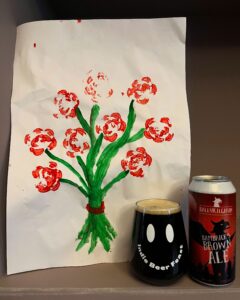 The Session is back! I missed its most recent return last month (I blame holidays) and nearly missed it again (general life stuff), but managed find a brief window to put something together. The question posed is quite a simple one, and thanks to Ray & Jess for the prompt:
The Session is back! I missed its most recent return last month (I blame holidays) and nearly missed it again (general life stuff), but managed find a brief window to put something together. The question posed is quite a simple one, and thanks to Ray & Jess for the prompt: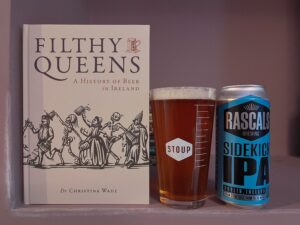 These days, it’s…well, not rather more sedate, since it was largely that way to begin with, but it does involve better pizza and more child-friendly programming (or did, until said children got ‘old’ themselves and/or bored with our viewing choices – I have no regrets about saving The Great Pottery Throw-down or other life-affirming programming for this use case every week). When Friday rolls around, we order pizza and have a few beers. I always like to have at least one Irish beer to kick off the evening, and then I may have a more ‘exotic’ follow-up, but I have the following in constant Friday night rotation:
These days, it’s…well, not rather more sedate, since it was largely that way to begin with, but it does involve better pizza and more child-friendly programming (or did, until said children got ‘old’ themselves and/or bored with our viewing choices – I have no regrets about saving The Great Pottery Throw-down or other life-affirming programming for this use case every week). When Friday rolls around, we order pizza and have a few beers. I always like to have at least one Irish beer to kick off the evening, and then I may have a more ‘exotic’ follow-up, but I have the following in constant Friday night rotation: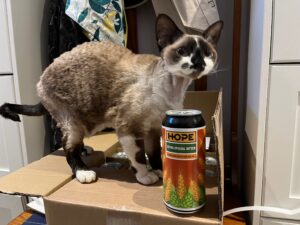 2) Rascals Sidekick IPA, 5.3% – gather around, children, and you’ll hear the tale of how IPAs used to be clear and bitter, but with a nice malty heft to them. Relive that experience at home, with this wonderfully balanced beer – pour it from the can into a glass, hold it up to the light and look through! While this does appear on tap at Rascals itself as part of their regular lineup now, it’s not flip-flops distance like Juno; I love it on tap, but it’s a must-have for a relaxed Friday night at home.
2) Rascals Sidekick IPA, 5.3% – gather around, children, and you’ll hear the tale of how IPAs used to be clear and bitter, but with a nice malty heft to them. Relive that experience at home, with this wonderfully balanced beer – pour it from the can into a glass, hold it up to the light and look through! While this does appear on tap at Rascals itself as part of their regular lineup now, it’s not flip-flops distance like Juno; I love it on tap, but it’s a must-have for a relaxed Friday night at home.


